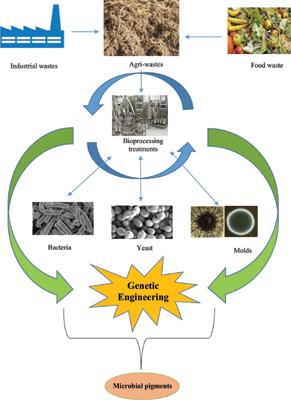当前位置:
X-MOL 学术
›
Curr. Genomics
›
论文详情
Our official English website, www.x-mol.net, welcomes your
feedback! (Note: you will need to create a separate account there.)
Engineered microbes for pigment production using waste biomass
Current Genomics ( IF 1.8 ) Pub Date : 2020-05-20 , DOI: 10.2174/1389202921999200330152007 Zeba Usmani 1 , Minaxi Sharma 1 , Surya Sudheer 1 , Vijai K Gupta 1 , Rajeev Bhat 1
Current Genomics ( IF 1.8 ) Pub Date : 2020-05-20 , DOI: 10.2174/1389202921999200330152007 Zeba Usmani 1 , Minaxi Sharma 1 , Surya Sudheer 1 , Vijai K Gupta 1 , Rajeev Bhat 1
Affiliation

|
Agri-food waste biomass is the most abundant organic waste and has high valorisation potential for sustainable bioproducts development. These wastes are not only recyclable in nature but are also rich sources of bioactive carbohydrates, peptides, pigments, polyphenols, vitamins, natural antioxidants, etc. Bioconversion of agri-food waste to value-added products is very important towards zero waste and circular economy concepts. To reduce the environmental burden, food researchers are seeking strategies to utilize this waste for microbial pigments production and further biotechnological exploitation in functional foods or value-added products. Microbes are valuable sources for a range of bioactive molecules, including microbial pigments production through fermentation and/or utilisation of waste. Here, we have reviewed some of the recent advancements made in important bioengineering technologies to develop engineered microbial systems for enhanced pigments production using agri-food wastes biomass/by-products as substrates in a sustainable way.
中文翻译:

利用废弃生物质生产颜料的工程微生物
农业食品废弃物生物质是最丰富的有机废弃物,对于可持续生物产品的开发具有很高的增值潜力。这些废物不仅本质上可回收,而且是生物活性碳水化合物、肽、色素、多酚、维生素、天然抗氧化剂等的丰富来源。将农业食品废物生物转化为增值产品对于零废物和循环经济非常重要概念。为了减轻环境负担,食品研究人员正在寻求利用这些废物生产微生物色素的策略,并进一步在功能性食品或增值产品中进行生物技术开发。微生物是一系列生物活性分子的宝贵来源,包括通过发酵和/或利用废物生产微生物色素。在这里,我们回顾了重要生物工程技术的一些最新进展,以开发工程微生物系统,以可持续的方式使用农业食品废物生物质/副产品作为基质来提高颜料生产。
更新日期:2020-05-20
中文翻译:

利用废弃生物质生产颜料的工程微生物
农业食品废弃物生物质是最丰富的有机废弃物,对于可持续生物产品的开发具有很高的增值潜力。这些废物不仅本质上可回收,而且是生物活性碳水化合物、肽、色素、多酚、维生素、天然抗氧化剂等的丰富来源。将农业食品废物生物转化为增值产品对于零废物和循环经济非常重要概念。为了减轻环境负担,食品研究人员正在寻求利用这些废物生产微生物色素的策略,并进一步在功能性食品或增值产品中进行生物技术开发。微生物是一系列生物活性分子的宝贵来源,包括通过发酵和/或利用废物生产微生物色素。在这里,我们回顾了重要生物工程技术的一些最新进展,以开发工程微生物系统,以可持续的方式使用农业食品废物生物质/副产品作为基质来提高颜料生产。











































 京公网安备 11010802027423号
京公网安备 11010802027423号